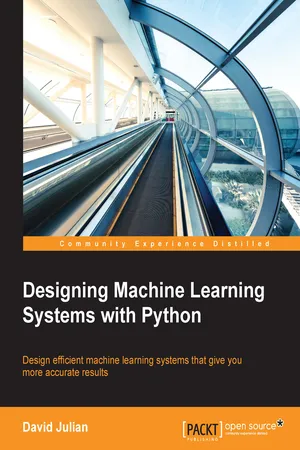![]()
Designing Machine Learning Systems with Python
![]()
Table of Contents
Designing Machine Learning Systems with Python
Credits
About the Author
About the Reviewer
www.PacktPub.com
eBooks, discount offers, and more
Why subscribe?
Preface
What this book covers
What you need for this book
Who this book is for
Conventions
Reader feedback
Customer support
Downloading the example code
Errata
Piracy
Questions
1. Thinking in Machine Learning
The human interface
Design principles
Types of questions
Are you asking the right question?
Tasks
Classification
Regression
Clustering
Dimensionality reduction
Errors
Optimization
Linear programming
Models
Geometric models
Probabilistic models
Logical models
Features
Unified modeling language
Class diagrams
Object diagrams
Activity diagrams
State diagrams
Summary
2. Tools and Techniques
Python for machine learning
IPython console
Installing the SciPy stack
NumPY
Constructing and transforming arrays
Mathematical operations
Matplotlib
Pandas
SciPy
Scikit-learn
Summary
3. Turning Data into Information
What is data?
Big data
Challenges of big data
Data volume
Data velocity
Data variety
Data models
Data distributions
Data from databases
Data from the Web
Data from natural language
Data from images
Data from application programming interfaces
Signals
Data from sound
Cleaning data
Visualizing data
Summary
4. Models – Learning from Information
Logical models
Generality ordering
Version space
Coverage space
PAC learning and computational complexity
Tree models
Purity
Rule models
The ordered list approach
Set-based rule models
Summary
5. Linear Models
Introducing least squares
Gradient descent
The normal equation
Logistic regression
The Cost function for logistic regression
Multiclass classification
Regularization
Summary
6. Neural Networks
Getting started with neural networks
Logistic units
Cost function
Minimizing the cost function
Implementing a neural network
Gradient checking
Other neural net architectures
Summary
7. Features – How Algorithms See the World
Feature types
Quantitative features
Ordinal features
Categorical features
Operations and statistics
Structured features
Transforming features
Discretization
Normalization
Calibration
Principle component analysis
Summary
8. Learning with Ensembles
Ensemble types
Bagging
Random forests
Extra trees
Boosting
Adaboost
Gradient boosting
Ensemble strategies
Other methods
Summary
9. Design Strategies and Case Studies
Evaluating model performance
Model selection
Gridsearch
Learning curves
Real-world case studies
Building a recommender system
Content-based filtering
Collaborative filtering
Reviewing the case study
Insect detection in greenhouses
Reviewing the case study
Machine learning at a glance
Summary
Index
![]()
Designing Machine Learning Systems with Python
Copyright © 2016 Packt Publishing
All rights reserved. No part of this book may be reproduced, stored in a retrieval system, or transmitted in any form or by any means, without the prior written permission of the publisher, except in the case of brief quotations embedded in critical articles or reviews.
Every effort has been made in the preparation of this book to ensure the accuracy of the information presented. However, the information contained in this book is sold without warranty, either express or implied. Neither the author, nor Packt Publishing, and its dealers and distributors will be held liable for any damages caused or alleged to be caused directly or indirectly by this book.
Packt Publishing has endeavored to provide trademark information about all of the companies and products mentioned in this book by the appropriate use of capitals. However, Packt Publishing cannot guarantee the accuracy of this information.
First published: April 2016
Production reference: 1310316
Published by Packt Publishing Ltd.
Livery Place
35 Livery Street
Birmingham B3 2PB, UK.
ISBN 978-1-78588-295-1
www.packtpub.com
![]()
Author
David Julian
Reviewer
Dr. Vahid Mirjalili
Commissioning Editor
Veena Pagare
Acquisition Editor
Tushar Gupta
Content Development Editor
Merint Thomas Mathew
Technical Editor
Abhishek R. Kotian
Copy Editor
Angad Singh
Project Coordinator
Suzanne Coutinho
Proofreader
Safis Editing
Indexer
Rekha Nair
Graphics
Disha Haria
Jason Monteiro
Production Coordinator
Aparna Bhagat
Cover Work
Aparna Bhagat
![]()
David Julian is currently working on a machine learning project with Urban Ecological Systems Ltd and Blue Smart Farms (http://www.bluesmartfarms.com.au) to detect and predict insect infestation in greenhouse crops. He is currently collecting a labeled training set that includes images and environmental data (temperature, humidity, soil moisture, and pH), linking this data to observations of infestation (the target variable), and using it to train neural net models. The aim is to create a model that will reduce the need for direct observation, be able to anticipate insect outbreaks, and subsequently control conditions. There is a brief outline of the project at http://davejulian.net/projects/ues. David also works as a data analyst, I.T. consultant, and trainer.
![]()
Dr. Vahid Mirjalili is a data scientist with a diverse background in engineering, mathematics, and computer science. With his specialty in data mining, he is very interested in predictive modeling and getting insights from data. Currently, he is working towards publishing a book on big data analysis, which covers a wide range of tools and techniques for analyzing massive data sets. Furthermore, as a Python developer, he likes to contribute to the open source community. He has developed Python packages for data clustering, such as PyClust. A collection of...
